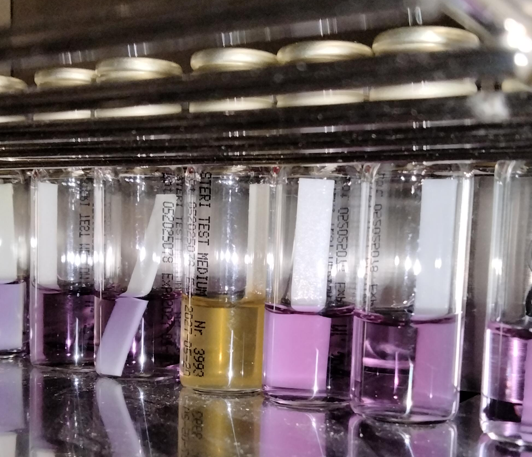
Testing Aerosolized Hydrogen Peroxide Disinfection Efficacy in Real World Conditions
Part 1 of this series explains the real-world conditions that affect disinfectant efficacy, and Part 2 explains different methods to test disinfection efficacy in real-world settings. This blog describes an example of applying these tests to measure and validate disinfection efficacy.
At Breezy Med, we have used all five test methods described in Part 2 within different situations to better understand and validate the use cases for our aerosolized hydrogen peroxide (aHP) disinfection solutions. After years of using the various test methods, we have settled upon a combination of Biological Indicator Testing combined with Electrochemical Sensors for our disinfection efficacy testing and validation. We have found that this combination offers a way to correlate pathogen log reduction efficacy to chemical fog dosage, all of this tested in real-world conditions with real-world variables. Here is how we do our testing.
Overview on Breezy Med's Automated Aerosolized Hydrogen Peroxide Solutions
Our disinfection solutions combine Aerosolized Hydrogen Peroxide (aHP) technology with smart device automation. Our data shows that aHP offers the best combination of efficacy, safety and sustainability. When aerosolized, Hydrogen Peroxide rapidly evaporates by breaking down into hydroxyl ions that recombine into water vapor and oxygen gas. The hydroxyl ions attack essential cell components in an oxidation process. When evaporation is complete, the fully recombined water and oxygen are completely benign, safe, and sustainable. And our smart device automation takes out the variability and unpredictability of disinfecting by hand. Breezy Blue™ is a highly efficient dry fogger that is safe for use on a variety of surfaces, including floors, walls, and electronics. Breezy Blue is a smart device that can be programmed for specific fogging dosages, with all disinfection history stored electronically.
Aerosolized Hydrogen Peroxide Disinfection Test Setup
Our hospital-grade aHP disinfectant, Breezy HaloSpray has been tested within third-party GLP Labs and is registered with the EPA as a disinfectant for MRSA, Pseudomonas, Norovirus, COVID-19, various Flu viruses, HIV, ringworm and more. In addition to the GLP lab testing, Breezy Med performs rigorous in-house testing using established scientific methods to develop protocols for whole-room disinfection of bacterial spores, which are some of the most challenging pathogens to kill.
We developed aHP fogging and re-entry protocols for 4-log, 5-log, and 6-log reductions of bacterial spores, using Bacillus atrophaeus Biological Indicators (BIs). B. atrophaeus is a commonly used surrogate for Clostridioides difficile (C. diff) spores. Our BI testing is conducted in combination with Electrochemical Sensors to develop and validate our fogging protocols. Testing used Liofilchem’s STRIP CONTROL BAT E4, E5, E6, which are paper strips inoculated with a predefined concentration of B. atrophaeus. To test coverage, BI strips and hydrogen peroxide/particulate sensors are placed at different heights throughout a test room. This allows for a comprehensive correlation of chemical distribution with pathogen log reduction. After a disinfection event, the strips are placed in a culture medium and incubated for seven days at 86-95°F. A successful disinfection is indicated by the medium remaining purple, while a failed test results in a color change to yellow, signifying growth of any remaining bacterial spores (see Figure 1).

Figure 1. Incubation of B. atrophaeus test strips in a culture medium
Aerosolized Hydrogen Peroxide Disinfection Test Results
Multiple fogging tests were conducted to correlate specific hydrogen peroxide dosages with the desired log-kill efficacy.
The peak dosage, measured in parts per million (PPM), of hydrogen peroxide (H₂O₂) was determined for each log reduction using sensor data from successful disinfection tests for rooms of various sizes. All protocols were based upon a minimum
10-minute contact time after aHP fogging. Dosages for 4-log to 6-log reductions can be quantified as follows and as shown in Figure 2.
- 4-log protocol: 25 ppm peak hydrogen peroxide
- 5-log protocol: 40 ppm peak hydrogen peroxide
- 6-log protocol: 55 ppm peak hydrogen peroxide

Figure 2. aHP fogging dosages using Breezy Blue with a 10-minute contact time
Safe re-entry times were determined by analyzing sensor data against OSHA standards for hydrogen peroxide and silver nitrate exposure. For hydrogen peroxide: the maximum exposure limit is <75 PPM and the 8-hour time-weighted average (TWA) limit is <1 PPM. All of our aHP protocols stay well below the maximum exposure limit and the TWA limit is used to calculate re-entry times as follows:
- 4-log protocol: immediate re-entry after 10-minute contact time
- 5-log protocol: immediate re-entry after 10-minute contact time
- 6-log protocol: re-entry after 13 minutes (10-minute contact time+ 3 minutes)
For the Silver Nitrate within Breezy HaloSpray, third-party testing confirmed that airborne silver concentrations never exceeds the detection limit (2.5 μg/sample), remaining well below the OSHA 8-hour TWA of 10 μg/m³. Therefore, airborne silver exposure is not a re-entry concern.
By testing our products for efficacy in a real-world application and experimenting with different variables, Breezy Med can provide recommended fog times for rooms of various sizes. Fogging guidelines for Breezy Blue can be calculated using our Fogging Time Calculator. All of our aHP fogging guidelines are based upon a 10-minute dwell time where there is no airflow in the room for 10 minutes post fogging.
We have tested other environmental conditions to determine effects on aHP fogging. Our results show that elevated temperature increases pathogen reduction, elevated humidity increases pathogen reduction, and airflow that does not dilute air in the room has little effect. Other environmental variables such as room shape, density of surfaces in room, and HVAC airflow may affect fogging time. For these situations, Breezy Med can fine tune fogging times using its Breezy Sense™ smart sensor that generates a real-time measurement of disinfectant dosage.
As a side note, in our attempt to qualify other chemistries for use with Breezy Blue, we have tested many other disinfectants using these test protocols. Unfortunately, we have found other disinfectants to be lacking in one or more of the following areas: low efficacy, too wetting, highly corrosive, and/or highly toxic.
Summary
At Breezy Med, we use science, technology, and data to develop our products and solutions, and to educate our users and partners. Because the COVID-19 pandemic created some confusion and misinformation related to effective disinfection, it is most important that we be very thorough in validating our products and their use cases. We want to ensure that our users can keep their facilities healthy and safe, and can promote their efforts to their occupants and visitors.
Part 1: Why Real-World Efficacy Testing is Needed
Part 2: Five Methods of Testing Disinfection Efficacy in the Real World
Part 3: Testing Aerosolized Hydrogen Peroxide Disinfection Efficacy in Real World Conditions




